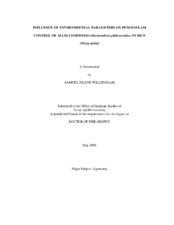| dc.description.abstract | Alligatorweed is a perennial plant which reproduces vegetatively and has spread from
waterways into canals and ultimately into rice fields of Louisiana and Texas.
Penoxsulam is a new acetolactate synthase (ALS) inhibiting broad-spectrum herbicide
that was registered for rice in 2005. Previous research on alligatorweed control has
focused mainly in aquatic areas and in the rice producing regions of Louisiana with little
success. Research is limited using penoxsulam for alligatorweed control in rice
production and results vary between year and location. Variability could be due to
growth habit and resource allocation of this perennial species. Therefore, field and
laboratory experiments were conducted from 2004 to 2007 to: 1) evaluate the effects of
select rice herbicides on alligatorweed control, 2) determine the absorption and
translocation efficiency and the effect of propanil on penoxsulam in alligatorweed 3)
access the environmental effects of temperature on penoxsulam efficacy and determine
application timing to avoid antagonism with propanil and, 4) evaluate the effects of
flood timing and rice cultivars on rice root stunting and plant foliar injury from
penoxsulam applications. Alligatorweed control was obtained from penoxsulam or bispyribac-sodium applied
alone; however, mixtures with propanil were antagonistic. Day temperatures at 21 C
increased efficacy of penoxsulam compared to 27 and 30 C day temperatures. Delaying
propanil applications 3 days following penoxsulam applications were required at 21 and
27 C and 10 days at 30 C in order to avoid antagonism. Alligatorweed absorbed up to
33% of penoxsulam when applied alone, but most was retained in treated leaves (29%).
Propanil reduced penoxsulam absorption into alligatorweed with only 22% of total
penoxsulam recovered being absorbed by alligatorweed. More than 50% remained on
the leaf surface of the treated leaf. Previous research has indicated root stunting of rice
plants from ALS inhibiting herbicides. When various rice varieties were permanently
flooded one week after herbicide application of penoxsulam, root stunting was greater
compared to delaying flood establishment 7 or 14 days after treatment. Significant root
stunting, however, did not affect rice yield. | en |


